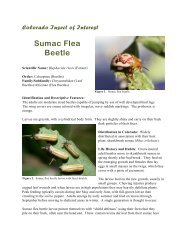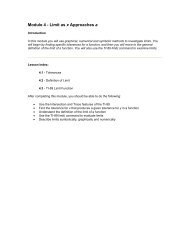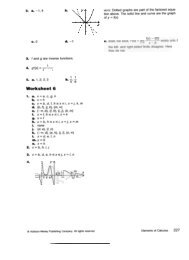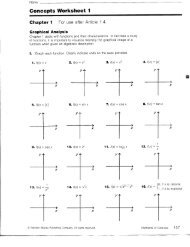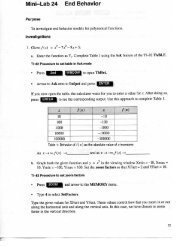The van Hiele Model of the Development of Geometric Thought
The van Hiele Model of the Development of Geometric Thought
The van Hiele Model of the Development of Geometric Thought
You also want an ePaper? Increase the reach of your titles
YUMPU automatically turns print PDFs into web optimized ePapers that Google loves.
LEARNING AND TEACHING GEOMETRY. K-12<br />
Properties <strong>of</strong> <strong>the</strong> <strong>Model</strong><br />
In addition to furnishing insights into <strong>the</strong> thinking that is specific to each<br />
level <strong>of</strong> geometric thought, <strong>the</strong> <strong>van</strong> <strong>Hiele</strong>s identified somc generalities that<br />
characterize <strong>the</strong> model. <strong>The</strong>se properties are particularly significant to ed-<br />
ucators because <strong>the</strong>y provide guidance for making instructional decisions.<br />
1. Sequential. As with most developmental <strong>the</strong>ories, a person must pro-<br />
cecd through <strong>the</strong> levels in order. To function successfully at a particular<br />
level, a learner must have acquired <strong>the</strong> strategies <strong>of</strong> <strong>the</strong> preceding levels.<br />
2. Ad<strong>van</strong>cement. Progress (or lack <strong>of</strong> it) from level to level depends more<br />
on <strong>the</strong> content and methods <strong>of</strong> instruction received than on age: No method<br />
<strong>of</strong> instruction allows a student to skip a level; some methods enhance prog-<br />
ress, whereas o<strong>the</strong>rs retard or even prevent movemcnt bctwcen levels. Van<br />
<strong>Hiele</strong> points out that it is possible to teach "a skillful pupil abilities above<br />
his actual level, like one can train young children in <strong>the</strong> arithmetic <strong>of</strong> frac-<br />
tions without telling <strong>the</strong>m what fractions mean, or older children in differ-<br />
entiating and integrating though <strong>the</strong>y do no know what differential quotients<br />
and integrals are" (Freudenthal 1973, p. 25). Geomctric examples include<br />
<strong>the</strong> memorization <strong>of</strong> an area formula or relationships like "a square is a<br />
rectangle." In situations like <strong>the</strong>se. what has actually happened is that <strong>the</strong><br />
subject matter has been reduced to a lower level and understanding has not<br />
occurred.<br />
3. Intrinsic and extrimic. <strong>The</strong> inhcrent objects at one level become <strong>the</strong><br />
objects <strong>of</strong> study at <strong>the</strong> next lcvcl. For example, at level O only <strong>the</strong> form <strong>of</strong> a<br />
figure is perceived. Thc figure is. <strong>of</strong> course, dctcrrnined by its properties.<br />
but it is not until level 1 that <strong>the</strong> figurc is analyzed and its components and<br />
properties are discovered.<br />
4. Linguisticr. "Each level has its own linguistic symbols and its own<br />
systems <strong>of</strong> relations connecting <strong>the</strong>se symbols" (I? <strong>van</strong> Hiclc 1984a, p. 246).<br />
Thus a relation that is "correct" at one lcvcl may be modified at ano<strong>the</strong>r<br />
level. For example, a figure may have more than one name (class inclu-<br />
sion)-a square is also a rectangle (and a parallclogram!). A student at<br />
level I does not conceptualize that this kind <strong>of</strong> nesting can occur. This typc<br />
<strong>of</strong> notion and its accompanying language. however. are fundamental<br />
at level 2.<br />
5. Mirmatch. If <strong>the</strong> student is at onc lcvcl and instruction is at a different<br />
level, <strong>the</strong> desired learning and progress may not occur. In particular, if <strong>the</strong><br />
teacher, instructional materials, content. vocabulary, and so on. are at a<br />
higher level than <strong>the</strong> lcarner, <strong>the</strong> student will not be able to follow <strong>the</strong><br />
thought processes being used.




